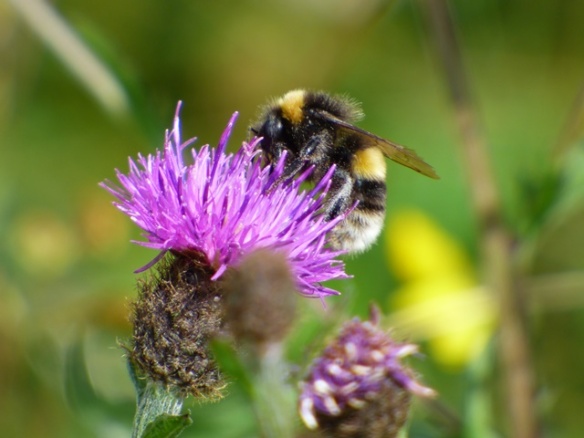We are heading west in our blog today, Ayrshire to be precise. In the land famous for Rabbie Burns, golf, and farming there is a project that captured the dynamic spirit of this area perfectly – the Irvine to Girvan Nectar Network.

Quite simply the project aims to establish connected nectar and pollen-rich sites along the beautiful Ayrshire coast to ensure the long-term survival of pollinating insects. Delivering such an ambitious project, which embraces a landscape scale approach to conservation, relies on solid partnership working, and the collaboration between businesses, NGOs and local authorities is reaping rewards for pollinators.
It is extremely heartening that so many diverse organisations and bodies were willing to lend their weight to this project. Local wildlife groups and activists are to be congratulated on raising awareness of the value of our vital pollinating insects. They highlighted the staggering fact that over 95% of the UK’s wildflower meadows has been lost in just the last 40 years or so, and sought to tackle that central issue head on.

Enlarging, improving and connecting areas of green space to create a series of green networks for pollinators is great news, particularly when the connectivity of sites is placed at the very heart of a project. Habitats where pollinating insects can thrive are now very restricted. Nectar gives insects energy to travel across the landscape so a lack of refuelling sites prevents this. An isolated insect population is a vulnerable one because, if it dies out for whatever reason, the site cannot be recolonised from nearby.
The Scottish Wildlife Trust manages and oversees a project which ultimately brings together various individual plots into one whole. Thus 32 sites are managed by 21 different operators and an additional 10 organisations or individuals support the project in other ways. Having both North and South Ayrshire Council at the heart of this work is a particular strength.
Ayrshire is one of Scotland’s golfing hot spots. It is therefore significant that there is fantastic involvement from the golf sector which resulted in generous funding from golf’s governing body, The R&A, from 2015 to 2018 which allowed for a part time project officer and some project materials. The R&A’s support has been extended for a further three years to help add more sites to the network and increase those participating in and contributing to the initiative
Practical on-the-ground measures included Glasgow Gailes, Western Gailes, Dundonald Links and Royal Troon golf courses all sowing new wildflower areas in spring 2018. One notable feature was that the works didn’t affect play at all, and in total 14 golf courses embraced the concept of stripping out areas of tough grass and replacing them with wildflower seeds (and it should be noted that the bare earth in some locations is a potential habitat for mining bees).
Material costs can be a big consideration in a project of this scale. Kidney vetch, the sole food plant of the Small Blue butterfly, has been included in the North Ayrshire coastal seed mix to support re-introduction of this declining species. It is, however, expensive. To counter this cost a nursery was established and the seedlings are doing well. Now the key to continued success will be monitoring the growth of surrounding grassland and intervene where necessary.

Raising awareness of the project is a crucial element of achieving success. Social media plays a huge role here, but so too does word of mouth and gathering people together. Thus a popular pollinator awareness day was run at Ayr/Ailsa Hospital where a large bug hotel was constructed, and plug plants put in round about it. That’s the kind of visible community involvement that really reaches out to people and presses home key messages.
Adopting pollinator friendly-practices takes many forms. One telling contribution was the earmarking of 10 hectares of Stevenston Beach Park for a change in the cutting regime. Here North Ayrshire Council allowed the grass and flowers to grow until late summer when it was cut and removed. This was in response to discussions with local environmental volunteers but the council was also careful to consult everyone so that the practice was widely accepted by the whole community.
Clearly the project is ambitious, but it is also very sensibly grounded and realistic. By concentrating on the link between the two Ayrshire towns of Irvine and Girvan the chances of success increased. This is a manageable geographic limit, and demonstrating success in this area could well act as a catalyst to further actions elsewhere in the region. That ‘walk before you run’ approach is highly commendable.

Of course, it is people that lie at the heart of delivering this project. And everyone has something they can bring to the table. Those have land are well placed to create and improve habitat for pollinators. Owners of equipment and materials can make a valuable contribution, and the time given up by volunteers is absolutely vital. Finally there are costs associated with most projects so those who fund activities are undoubtedly making a huge impact.
We’ve found ourselves in a far from ideal place with regard to pollinator numbers. How fantastic then to see that groups like the Nectar Network are going full steam to meet the challenges head on. With this kind of approach the future is looking much brighter.
Stay in touch:
The above blog gives just a flavour of what goes on in the Nectar Network –
follow it on Facebook @ www.facebook.com/IrvinetoGirvanNectarNetwork/
And on twitter @Nectar_Network
Further reading:
Scottish Wildlife Trust
The R & A
Butterfly Conservation – Small blue
Stevenston Conservation

















